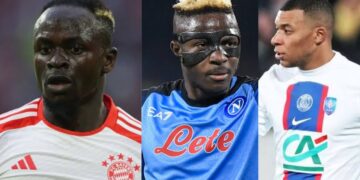The first offseason under the new Collective Bargaining Agreement between MLB and the MLB Players Association has been, to say the least, eye-opening.
With labor peace assured for at least a few seasons, teams handed out massive long-term contracts including startling numbers on what feels like a weekly basis. Aaron Judge got $360 million from the Yankees. Shortstops Trea Turner, Xander Bogaerts and Carlos Correa all landed deals lasting at least 11 years; heck, Correa got two of them after medicals scuttled his deal with the Giants (and we’ll see what happens with the Mets situation).
MORE: The thought process behind MLB’s surge of long-term contracts
And even as that all unfolded, one question was in the back of the minds for those around the sport: If the Angels cannot sign Shohei Ohtani to an extension between now and the end of the 2023 season — more on that in a moment — what happens when Ohtani becomes a free agent next offseason?
“Honestly, he’s the most unique free agent in the history of the game,” Dan O’Dowd, the MLB Network Analyst who was GM of the Rockies for 15 years, said in a recent phone interview. “So we are all in uncharted territories.”
We certainly are. It’s not a stretch to say Ohtani will be the most anticipated, fascinating and desired free agent in baseball’s free-agent era.
Ohtani won the AL MVP in 2021 with an unprecedented performance as both an elite hitter and pitcher, and it took a truly historic effort from Aaron Judge to keep him from winning the award again in 2022. Truth is, though, Ohtani was actually a bit better in 2022 than he was the year before — he had a combined 9.6 bWAR (3.4 as a position player, 6.2 as a pitcher) in 2022 after a combined 9.0 bWAR (4.9 and 4.1, respectively) in 2021. He finished fourth in the AL Cy Young voting.
Truly mind-boggling stuff, and it’s easy to get off-topic when talking about Ohtani and his brilliance. But the question today: What will free agency look like for Ohtani next offseason?
For starters, it looks lucrative for the superstar who turns 29 this July.
“You’re paying for two positions with one signing,” O’Dowd said. “Even if he should get hurt as a pitcher, the bat and the base-running, and I think he’d be an elite defender in a corner outfield position, too. He’s just so unique. He’s a unicorn in every definition of the word in the game of baseball. I don’t think we can look at his contract in the context of any player we’ve discussed so far.”
Let’s look at a few numbers, starting with pitching.
Carlos Rodon is about a year-and-a-half older than Ohtani. Both were injured most of 2020, then outstanding on the mound the past two seasons. Combined numbers here …
Rodon: 10.5 bWAR/11.1 fWAR, 2.67 ERA, 2.42 FIP, 12.2 K/9, 310 2/3 innings
Ohtani: 10.3 bWAR/8.6 fWAR, 2.70 ERA, 2.98 FIP, 11.4 K/9, 296 1/3 innings
Pretty darn similar, right? Rodon was better, but not significantly. If Ohtani was “just” a starting pitcher with those numbers, it’s easy to imagine that he’d land deal equal to or better than the six-year, $162 million free agent deal Rodon got from the Yankees. Justin Verlander and Jacob deGrom both earned massive deals this offseason, too, though Verlander’s age and deGrom’s health issues hurt potential Ohtani comparisons. Both deals do, though, speak to the premium teams put on starters with big swing-and-miss numbers.
And offensively? Oh yeah, he’s an elite slugger, too. You can’t really compare Ohtani as a designated hitter to the shortstops who signed this offseason because, well, they’re shortstops. They play a premium defensive position and they play it well. So instead, let’s just look at where Ohtani ranks as a heart-of-the-order bat across the sport.
In the past two seasons, he’s tied for second in the majors in homers (80), second in triples (14), seventh in slugging percentage (.554), seventh in total bases (622) and eighth in OPS+ (152). Heck, he’s even 18th in stolen bases, with 37. Elite production across the board. That’s the kind of production teams love to add through free agency, especially as a left-handed bat in the days after the end of the shift.
So let’s talk about another number: total contract value.
Judge’s $360 million was the largest deal given to a free agent. Mike Trout ($426.5 million) and Mookie Betts ($365 million) have bigger total numbers, but both contracts were signed as extensions, not on the open market. If Ohtani is healthy and comes even close to what he’s done the past few seasons, he blows past Judge.
Where does the bidding stop? At $375 million? Maybe $400 million? It’s not impossible to think about Ohtani eclipsing Trout’s total value of $426.5 million. And if we’re already approaching ludicrous speed, why would the bidding stop there? Maybe $450 million? More?
Because here’s the thing: Ohtani isn’t only a unicorn on the field. He is baseball’s most marketable superstar, on a truly global level like no other player, and he’s only scratched the surface. There’s a reason the Angels haven’t traded him yet, even though it makes all the baseball sense in the world for them to jumpstart a much-needed franchise overhaul with the massive haul of talent he would command. There seemingly is no limit to the value — revenue, exposure, you name it — that 10 to 12 years of Ohtani could bring to a franchise.
I asked O’Dowd whether he had a number in mind.
“I haven’t really speculated at that yet,” he said. “But, again, he’s a very, very unique player, so it’s hard for me to even wrap my mind around any player getting that kind of money, but he’s a very, very special player.”
So, final question: Where does Ohtani wind up?
Before we answer that, we have to talk about the Angels. Ohtani’s current team will do everything possible to keep him in Anaheim the rest of his career, as they should now that it’s apparent they do not intend to deal him (still the smart baseball-only move). It seems unlikely that he’ll sign another contract with the Angels; he’s been pretty clear about his frustration with the constant losing and inability to even sniff a playoff berth. That’s a big reason you’ve seen the Angels active this offseason, kind of one final push to see whether a wild-card run changes his mind. Again, seems unlikely. Not impossible, but unlikely.
MORE: If the Angels are keeping Shohei Ohtani, here’s a blueprint for 2023 success
He wants to win, and the Angels haven’t even finished at .500 during his five seasons with the club. In 2022, the team finished 33 games out of first place in the AL West and 13 games out of the third wild-card spot. Even a postseason push in 2023 would only serve to disguise the large issues looming in the organization, and Ohtani knows that. And for all this to happen when owner Arte Moreno is actively looking to sell?
The safe bet is for Ohtani to reach free agency.
So which teams will be in the discussion? Every team would love to have Ohtani, of course, and most owners could financially make it happen — could, not would — but the better question is this: Where will Ohtani want to play? He can land a mind-boggling contract with any number of teams, so he’ll pretty much be able to name both his place and his price.
“He’s going to be, probably, so specific as far as his criteria as far as size of the market, winning capability, sustained winning capability. After what he’s gone through in Anaheim, I’m sure he’s going to be very particular,” O’Dowd said.
“Obviously, there’s only going to be a few organizations that have the capabilities financially to play at that level.”
The Mets, it figures, will be in the mix. Maybe they can change the unofficial name of the upper levels of the luxury tax from “The Steve Cohen Tax” to “The Cohen/Ohtani Tax.” The club’s two highest-paid players, Max Scherzer and Justin Verlander, both come off the books after the 2024 season, so there would be only one year of overlap.
MORE: TSN’s Ryan Fagan explains his 2023 BBWAA Hall of Fame ballot
The Dodgers have always coveted Ohtani. Same with the Yankees, though the long-term Judge and Rodon signings might make landing Ohtani more challenging. The Giants clearly have large amounts of money burning a hole in their pocket — we know what happened with attempts to wrap up Judge and Correa long term this offseason — but they’d have to show a team more competitive than the one that took the field in 2022. The idea of playing for the Mariners, with Julio Rodriguez and in the same stadium where Ichiro became a Hall of Famer, would be appealing for both the club and the player.
Most of the massive contracts have been handed out by teams closer to the coasts, but Ohtani’s the type of player who would appeal to any middle-of-the-country team, too. The Cubs immediately come to mind, and maybe the White Sox could be convinced to finally hand out a massive deal (You know what? Probably not.). And maybe don’t count out the Cardinals. They haven’t won many free-agent bidding wars, but you can bet Ohtani watched how much fun former teammate Albert Pujols had playing for a contending team last summer, with a franchise that always contends for a playoff spot.
Yep, 2023 has arrived, and both the Angels and Ohtani are officially on the clock.
Read the full article here


























